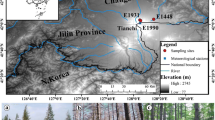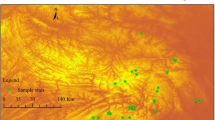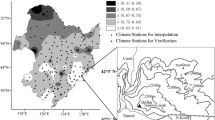Abstract
Key message
We investigated the variability of the relationships between climate and tree-ring growth along an altitudinal gradient and the temporal instability of the relationships under warming for Changbai larch ( Larix olgensis Henry) in northeast of China.
Abstract
Growth response of trees to climate has been found to vary with elevation, but their relationships might also be altered with ongoing global climate change. We developed residual chronologies of tree-ring growth parameters at three sites to investigate variability of the interactions between climate and tree-ring growth for Changbai larch (Larix olgensis Henry) along an altitudinal gradient on the northern slopes of the Changbai Mountains area in Northeastern China. The results indicate that temperature and precipitation are linked differently to the formation of the annual ring width of Changbai larch at different elevations. Tree-ring density of Changbai larch is mainly positively associated with temperature while negatively responding to precipitation. The relationships between temperature and tree-ring growth became unstable, however, after the notable warming of the late 1980s in the study area. Tree-ring width decreased at low elevation under drought stress, whereas showed more positive sensitivity to warming at higher altitudes. We found that the tree-ring density relationship with temperature also became unstable under the rising temperature regime. These findings could be applied in simulating tree-ring growth and forest distribution under various climatic and environmental scenarios.








Similar content being viewed by others
References
Alexandersson H, Moberg A (1997) Homogenization of Swedish temperature data. Part I: homogeneity test for linear trends. Int J Climatol 17:25–34
Allen CD, Macalady AK, Chenchouni H, Bachelet D, McDowell N, Vennetier M, Kitzberger T, Rigling A, Breshears DD, Hogg E (2010) A global overview of drought and heat-induced tree mortality reveals emerging climate change risks for forests. For Ecol Manag 259(4):660–684. doi:10.1016/j.foreco.2009.09.001
Anderegg WR, Kane JM, Anderegg LD (2013) Consequences of widespread tree mortality triggered by drought and temperature stress. Nat Clim Chang 3:30–36. doi:10.1038/nclimate1635
Biondi F (2000) Are climate–tree growth relationships changing in north-central Idaho, USA? Arct Antarct Alp Res 32:111–116
Bräuning A (1999) Dendroclimatological potential of drought-sensitive tree stands in southern Tibet for the reconstruction of monsoonal activity. IAWA J 20:325–338
Briffa KR, Jones PD (1990) Basic chronology statistics and assessment. In: Cook ER, Kairiukstis LA (eds) Methods of dendrochronology: applications in the environmental sciences. Kluwer Academic Publishers, Boston, pp 137–152
Chen XX, Yan XD (2008) Effects of climate change on typical forest in the northeast of China. Acta Ecol Sin 28:534–543 (in Chinese with English abstract)
Chen L, Wu SH, Pan T (2011) Variability of climate–growth relationships along an elevation gradient in the Changbai mountains, northeast China. Trees 25:1133–1139. doi:10.1007/s00468-011-0588-0
Cook ER (1985) A time-series approach to tree-ring standardization. Ph.D thesis, University of Arizona, Tucson, Arizona
Cook ER, Holmes RL (1996) Guide for computer program ARSTAN. In: Grissino-Mayer HD, Holmes RL, Fritts HC (eds) The international tree-ring data bank program library version 2.0 user’s manual. University of Arizona, Tucson, Arizona
Cook ER, Briffa KR, Shiyatov S, Mazepa V (1990) Tree-ring standardization and growth-trend estimation. In: Cook ER, Kairiukstis LA (eds) Methods of dendrochronology: applications in the environmental sciences. Kluwer Academic Publishers, Boston, pp 104–122
D’Arrigo RD, Wilson R, Liepert B, Cherubini P (2007) On the ‘divergence problem’ in northern forests: a review of the tree-ring evidence and possible causes. Global Planet Change 60(3–4):289–305. doi:10.1016/j.gloplacha.2007.03.004
Ding YH, Ren GY, Shi GY, Gong P, Zheng XH, Zhai PM, Zhang DE, Zhao ZC, Wang SW, Wang HJ (2006) National Assessment Report of Climate Change (I): climate change in China and its future trend. Adv Clim Chang Res 2(1):3–8
Dittmar C, Zech W, Elling W (2003) Growth variation of common beech (Fagus sylvatica L.) under different climatic and environmental conditions in Europe—a dendroecological study. For Ecol Manag 173:63–78. doi:10.1016/s0378-1127(01)00816-7
Driscoll WW, Wiles GC, D’Arrigo RD, Wilmking M (2005) Divergent tree growth response to recent climatic warming, Lake Clark National Park and Preserve, Alaska. Geogr Res Lett 32(20):L20703. doi:10.1029/2005GL024258
Fisher RA (1915) Frequency distribution of the values of the correlation coefficient in samples of an indefinitely large population. Biometrika 10(4):507–521. doi:10.2307/2331838
Fritts HC (1976) Tree rings and climate. Academic Press, London, p 23
Gierlinger N, Jacques D, Schwanniger M, Wimmer R, Pâques (2004) Heartwood extractives and lignin content of different larch species (Larix sp.) and relationships to brown-rot decay-resistance. Trees 18:230–236. doi:10.1007/s00468-003-0300-0
Hao ZQ, Dai LM, He HS, Malandnoff DJ, Shao GF (2001) Potential response of major tree species to climate warming in Changbai Mountains, northeast China. Chin J Appl Ecol 12(5):652–658 (in Chinese with English abstract)
He HS, Hao ZQ, Mladenoff DJ, Shao GF, Hu YM, Chang Y (2005) Simulating forest ecosystem response to climate warming incorporating spatial effects in north-eastern China. J Biogeogr 32(12):2043–2056. doi:10.1111/j.1365-2699.2005.01353.x
Holmes RL (1983) Computer-assisted quality control in tree-ring dating and measurement. Tree-Ring Bull 43:69–78
Holmes RL (1992) Dendrochronology Program Library, Version 1992–1. Laboratory of Tree-Ring Research, University of Arizona, Tucson, ArizonaLi GQ, Bai F, Sang WG (2011) Different responses of radial growth to climate warming limits in Pinus koraiensis and Picea jezoensis var. komarovii at their upper elevational limits in Changbai Mountains, China. Chin J Plant Ecol 35:500–511 (in Chinese with English abstract)
Li GQ, Bai F, Sang WG (2011) Different responses of radial growth to climate warming limits in Pinus koraiensis and Picea jezoensis var. komarovii at their upper elevational limits in Changbai Mountains, China. Chin J Plant Ecol 35:500–511 (in Chinese with English abstract)
Liang EY, Wang YF, Xu Y, Liu B, Shao XM (2010) Growth variation in Abies georgei var. smithii along altitudinal gradients in the Sygera Mountains, southeastern Tibetan Plateau. Trees 24:363–373. doi:10.1007/s00468-009-0406-0
Lloyd AH, Fastie CL (2002) Spatial and temporal variability in the growth and climate response to treeline trees in Alaska. Clim Chang 52(4):481–509. doi:10.1023/a:1014278819094
Magnin A, Puntieri J, Villalba R (2014) Interannual variations in primary and secondary growth of Nothofagus pumilio and their relationships with climate. Trees 28:1463–1471. doi:10.1007/s00468-014-1049-3
Mérian P, Bontemps JD, Bergés L, Lebourgeois F (2011) Spatial variation and temporal instability in climate–growth relationships of sessile oak (Quercus petraea [Matt.] Liebl.) under temperate conditions. Plant Ecol 212(11):1855–1871. doi:10.1007/s11258-011-9959-2
Pederson N, Cook ER, Jacoby GC, Peteet DM, Griffin KL (2004) The influence of winter temperatures on the annual radial growth of six northern range margin tree species. Dendrochronologia 22:7–29. doi:10.1016/j.dendro.2004.09.005
Peterson DW, Peterson DL (2001) Mountain hemlock growth responds to climatic variability at annual and decadal time scales. Ecology 82(12):3330–3345. doi:10.1890/0012-9658
Pilcher JR, Gray B (1982) The relationships between oak tree growth and climate in Britain. J Ecol 70:297–304
Salzer MW, Hughes MK, Bunn AG, Kipfmueller KF (2009) Recent unprecedented tree-ring growth in bristlecone pine at the highest elevations and possible causes. Proc Natl Acad Sci USA 106(48):20348–20353. doi:10.1073/pnas.0903029106
Savva Y, Oleksyn J, Reich PB, Tjoelker MG, Vaganov EA, Modrzynski J (2006) Inter-annual growth response of Norway spruce to climate along an altitudinal gradient in the Tatra Mountains, Poland. Trees 20:735–746. doi:10.1007/s00468-006-0088-9
Schweingruber FH (1988) Tree rings-basic and applications of dendrochronology. D. Reidel Publishing Company, Dordrecht, p 62
Serreae MC, Walsh JE, Chapin FS III, Osterkamp T, Dyurgerov M, Romanovsky V, Oechel WC, Morison J, Zhang T, Barry RG (2000) Observational evidence of recent change in the northern high-latitude environment. Clim Chang 46:159–207. doi:10.1023/A:1005504031923
SFA (State Forestry Administration of China) (2008) National forest resources statistics (2004–2008). State Forestry Administration, Beijing, China, pp 233 (in Chinese)
Shao XM, Wu XD (1997) Reconstruction of climate change on Changbai Mountains, northeast China using tree-ring data. Quat Sci 1:76–85 (in Chinese with English abstract)
Sun Y (2011) Response of tree growth to climate change and reconstruction of summer temperature based on Larix olgensis Henry and Larix gmelinii (Rupr.) Rupr. Ph.D thesis, Graduate University of Chinese Academy of Sciences, Beijing, China
Sun Y, Wang LL, Chen J (2012) Response of tree growth to climate change and reconstruction of summer temperature based on Korean larch. J Earth Environ 3(3):889–899 (in Chinese with English abstract)
Takahashi K, Tokumitsu Y, Yasue K (2005) Climate factors affecting the tree-ring width of Betula ermanii at the timberline on Mount Norikura, central Japan. Ecol Res 20:445–451. doi:10.1007/s11284-005-0060-y
Vaganov EA (1990) The tracheidogram method in tree-ring analysis and its application. In: Cook ER, Kairiukstis LA (eds) Method of dendrochronology. Application in the environmental sciences. Kluwer Academic Publishers, Dordrecht, pp 63–76
Walther GR, Post E, Convey P, Menzel A, Parmesan C, Beebee TJC, Fromentin B (2002) Ecological responses to recent climate change. Nature 416(28):389–395. doi:10.1038/416389a
Wang M, Tao DL (1998) Drought-tolerance of main tree species in Changbai Mountains, China. J Appl Ecol 9:7–10 (in Chinese with English abstract)
Wang Z, Xu ZB, Li X (1980) The main forest types and their features of community structure in northern slope of Changbai mountains (1). Res For Ecosyst 1:25–32 (in Chinese with English abstract)
Wang LL, Payette S, Bégin Y (2002) Relationships between anatomical and densitometric characteristics of black spruce and summer temperature at tree line in northern Quebec. Can J For Res 32:477–486. doi:10.1139/X01-208
Wang LL, Shao XM, Huang L, Liang EY (2005) Tree-ring characteristics of Larix Gmelinii and Pinus sylvestris Var. Mongolica and their response to climate in Mohe, China. Acta Phystoecologica Sinica 29(3):380–385 (in Chinese with English abstract)
Wang LL, Duan JP, Chen J, Huang L, Shao XM (2010) Temperature reconstruction from tree-ring maximum density of Balfour spruce in eastern Tibet, China. Int J Climatol 30:972–979. doi:10.1002/joc.2000
Wigley T, Briffa KR, Jones PD (1984) On the average value of correlated time series, with applications in dendroclimatology and hydrometeorology. J Climate Appl Meteorol 23:201–213
Wilson R, Elling W (2004) Temporal instability in tree-growth/climate response in the lower Bavarian Forest region: implications for dendroclimatic reconstruction. Trees 18(1):19–28. doi:10.1007/s00468-003-0273-z
Wu XD, Shao XM (1996) A preliminary study on impact of climate change on tree growth using tree ring-width data. Acta Geogr Sin 51:92–101 (in Chinese with English abstract)
Yu DP, Wang SZ, Tang LN, Dai LM, Wang QL, Wang SX (2005) Relationship between tree-ring chronology of Larix olgensis in Changbai mountains and the climate change. Chin J Appl Ecol 16(1):14–20 (in Chinese with English abstract)
Yu DP, Liu JQ, Lewis BJ, Li Z, Zhou WM, Fang XM, Wei YW, Jiang SW, Dai LM (2013) Spatial variation and temporal instability in the climate–growth relationship of Korean pine in the Changbai mountains region of Northeast China. For Ecol Manag 300:96–105. doi:10.1016/j.foreco.2012.06.032
Zhang XX, Wilmking M (2010) Divergent growth responses and increasing temperature limitation of Qinghai spruce growth along an elevation gradient at the northeast Tibet Plateau. For Ecol Manag 260:1076–1082. doi:10.1016/j.foreco.2010.06.034
Zhao ZC, Luo Y (2007) Projections of climate change over northeastern China for the 21st century. J Meteorol Environ 23(3):1–4 (in Chinese with English abstract)
Zhu KZ, Wan MM (1999) Phenology. Hunan Education Press, Changsha, pp 91–94
Zhu HF, Fang XQ, Shao XM, Yin ZY (2009) Tree ring-based February–April temperature reconstruction for Changbai Mountains in northeast China and its implication for east Asian winter monsoon. Clim Past 5:661–666
Acknowledgments
This work was supported by the National Science Foundation of China (41271120) and the Open Fund of the State Key Laboratory of Loess and Quaternary Geology (SKLLQG1320), Institute of Earth Environment, Chinese Academy of Sciences. We thank the China Meteorological Data Sharing Service System for sharing the climatic data, Dr. Yu Sun for his assistance with the sample collection, and the two anonymous reviewers and editors for their valuable review comments that helped greatly to improve our manuscript.
Author information
Authors and Affiliations
Corresponding author
Ethics declarations
Conflict of interest
The authors declare that they have no conflict of interest
Additional information
Communicated by S. Masaka.
Rights and permissions
About this article
Cite this article
Shen, C., Wang, L. & Li, M. The altitudinal variability and temporal instability of the climate–tree-ring growth relationships for Changbai larch (Larix olgensis Henry) in the Changbai mountains area, Jilin, Northeastern China. Trees 30, 901–912 (2016). https://doi.org/10.1007/s00468-015-1330-0
Received:
Revised:
Accepted:
Published:
Issue Date:
DOI: https://doi.org/10.1007/s00468-015-1330-0




